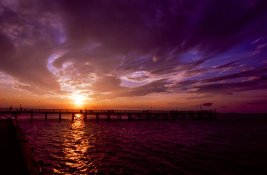Looking at the film itself you will find that slide film has latitude similar to negative film. In practice it might be that such latitude has been more of a consideration in the R&D of negative films, because it is much used in the field. That is especially true for amateur films. Still, in principle there is no difference between E6 and C41 film in that regard.
First an example to prove my claim above: I was out shooting slide films, using Provia 400X (6x6) after a roll of Velvia 50 and forgot to set the meter from EI 50 to 400. When I noticed I was a bit upset and then adjusted the meter. The plan was to forgo the misexposed images. At home I eventually decided to develop the film into negatives in the ECN2 process (same dev agent as E6). Looking at the finished (negative) film strip I could hardly see a difference between the EI50 and EI400 portion with the naked eye. That is film latitude, I guess.
The reason why you won't have any latitude when going for a slide is that the E6 process is fixed in all its parameters. It means a certain exposure will lead to a certain result. It's a fixed relationship. If you use negative film and go to colour print in the dark room with such fixed and *predetermined* parameters you will have zero latitude just the same as for slides:
Use a roll of Portra 400 and take perfectly exposed images, e.g. incident metered in a studio. Develop in C41 and take the film strip to your enlarger. Find the parameters to make perfect prints. Then use those same parameters (exposure time of the paper, filter pack, column height, etc) unchanged for all your future printing.
Now if you overexpose your next roll of Portra 400 by two stops you will get negatives but not get a useable image on your colour paper from those. It might give a very faint image or just pure white.
The trick with negatives is that you can adjust the second half of the process to the needs of your negative, and hence of the original scene. Portra can record most of the information in the scene even when it is very overexposed. The negatives will be denser and so you'll have to increase the exposure time under the enlarger to punch through that. And you may have to adjust your colour filter pack, as well.
Slide film will also perfectly record the information when equally overexposed. But in the E6 process and with two stops under/overexposure you will develop away that information, because the first dev time has been set to obtain a certain density when the film was correctly exposed. Only that density will translate to a viewable image upon reversal.
To prove my point: When you *KNOW* that you (over/under)exposed by one stop (i.e. an intentional pull/push by one stop) you tell the lab and they will process the film accordingly by adjusting the time of the first developer. You'll get great results from that. Indeed I've heard that in the old day slide film was the way to go for pushing, because the results are better than with negative film. However, your exposure will still need to be spot on at the chosen, pushed E.I.
I have pushed Provia 400X by two stops. Gives very usable results. But the max density is slightly lowered. I don't like the look of that too much because, most of the time, I'm a contrast whore and I don't like the deep blacks becoming slightly off-black.
But pushing that film one stop to EI 800 is a no brainer. And if you digitise them you'll adjust the black point of a two stop pushed image and get a perfect result with very little grain. That being said, when digitising slides that have a slightly wrong exposure they can be fully recovered. I recently had one of those. Great sky, underexposed city. I could fully recover that in digital post. But that still leaves me with a very imperfect slide for analog presentation.
Now, you'll surely ask about dynamic range next. The contrast of the final slide is intentionally high for a brilliant result. It is like printing b/w negatives onto grade 8 paper for an incredible brilliance.

A high contrast in the output medium, without the ability to cut out brightness ranges of the orginal scene (dodging, burning, masking) will reduce the maximum recordable dynamic range. It's how mathematics works...
In practice when printing in the dark room C41, too, is limited in dynamic range, unless you like burning and dodging. I don't like doing that with b/w film, let alone with colour film. My RA4 exposure times are too short to even try. And you may also run into colour shifts. If I'm lucky I will have masking equipment, eventually. In a few years, perhaps. Then I'd be able to print high contrast negatives, but with a lot of effort and extra cost of film for making masks.
The reason why many of us consider slides on a light table, or projected, to be 'nicer' than images from negatives is that brilliance of slides. The final image contrast is much higher than what colour paper or a computer screen can manage. C41 film is technically superior in its colour reproduction, but for the masses E6 will aesthetically look better than the technically near perfect C41 process.
I guess E6 vs C41 is like film vs digital (order intentional).












